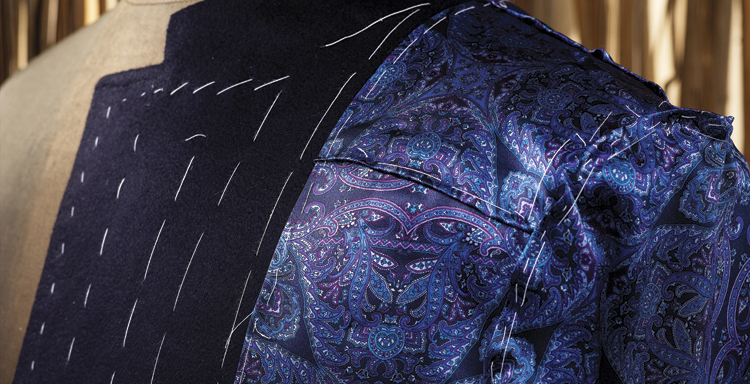Weaving
Weaving, the process that creates cloth, is surely the second oldest profession – the oldest being the production of stone arrow-heads, not what you were thinking, perhaps. Possibly as old as the Paleolithic, and certainly known in the Neolithic, weaving coincided with the domestication of animals, the planting of crops and the establishment of culture, settlements, buildings and pottery, and developed independently in many parts of the world.
Primitive protective covering very soon gave way to fabrics designed for warmth and comfort, and from the earliest times these products of man’s quest for survival have been embellished with patterns and colours. This creative streak, more than simple tool-making, is what sets man apart from the beasts, and the impetus today is as strong as it ever was.
The greatest advances in weaving since primitive times have been in the development of the fibres from which cloth is made. Flax and wool were the earliest fibres used in weaving, and while both are used today much as they were in Ancient Egypt, wool in particular has been transformed over centuries of careful selective breeding.
Wool
Although “wool” is usually taken to mean the fleece from a sheep, there are several other animals whose hair is termed wool. Goats, Vicuñas and their relatives the Alpacas all produce the long, thin and soft fibres that make wool fabrics.
Vicuña
Vicuña is the world’s most luxurious natural fibre. With each strand less than half the diameter of sheep’s wool, and 1/8th of the width of a human hair, Vicuña is prized for it’s incredible quality and comfort.
The vicuña is closely related to the llama. Unlike the llama and its cousin the alpaca, it cannot be domesticated. It cannot therefore be easily bred to a higher standard, and, living as it does at very high altitudes (over 4,000 metres), the wool is difficult to harvest. A single Vicuña on average yields only 200 grams of wool a year, but this is 200 grams of the finest natural fibre on earth. Measuring just 12 microns in diameter, compared to the best merino wool at 16-18 microns, vicuña wool is also the finest fibre capable of being spun.
Other luxury fibres include Mohair and Cashmere. A luxury even in Roman times, Cashmere fabric is made from the extremely soft wool in the under hair of goats. Almost all goats have this soft under hair to a greater or lesser extent, but none more so than the Asiatic Falconeri goat that lives and breeds in Kashmir, China, Mongolia, Afghanistan and Iran. Each goat is combed by hand in the spring when they are shedding the fine wool that protects them during the bitterly cold winters at high altitude.
If Vicuña and Cashmere are the queens of the natural fibre world, King Wool reigns supreme. At its absolute finest, wool can only begin to rival Vicuña, but it is produced in phenomenal quantities and has been a major factor in the economy of the civilised world since medieval times.
Australia’s economy also depends on wool, with annual production worth $2.6bn accounting for 30% of all wool produced in the world. 85% of this is fine quality Merino, the finest commercial wool available. Merino is long, fine, heavily crimped, and like the other wool fibres, has a rough, microscopically-scaled surface that helps the individual fibres bind easily together, in a light, soft and absorbent thread. The tiny gaps between the fibres both insulate and dry, wicking away moisture and provide a springy comfort and softness that is at the same time durable.
The business of producing and selecting the fibres for the world’s best quality suitings is a serious one. The sophisticated customers of the world’s very few Bespoke Tailors expect nothing less than the best. Sydney’s internationally-famous John Cutler, one of a handful of bespoke tailors, sources his fabrics from a select group of manufacturers. One of these, Italian fabric specialist Loro Piana, oversees the process from goat to throat when it comes to a cashmere scarf.
Cashmere
The cashmere goats are sheared and combed, and the fibres washed and sorted, before being sent to Loro Piana’s selection and testing centres in Hong Kong and Ulaan Bator for purchase and shipment.
Only the best is bought, and upon arrival in Italy it is analysed and further sorted, before being transformed into yarn and fabric through a combination of sophisticated technology and a personal, hands-on commitment to achieving the highest quality in the final product.
Loro Piana are positively active in the search for ever-finer and higher quality fibres. Strict protection measures brought in by the governments of Peru and Chile in the 1960s to protect the wild vicuña, hunted almost to extinction, included the banning of Vicuña fibre. By signing an agreement with the Peruvian Government in 1994 to handle the managed reintroduction of Vicuña fibre to the world market, Loro Piana have guaranteed the survival of these extraordinary animals. There are now over 100,000 vicuña in the wild.
Loro Piana are also active in promoting the development of higher standards in merino wool, by buying the best lots at the biannual auctions. Winning average fibre diameters have recently gone below 12 microns, and to promote this constant search for ever finer fibres, Loro Piana award the World Wool Record Challenge Cup to the finest bale of wool produced in the world every year.
But they have an endearing tradition: the finest bale bought is never transformed into yarn and fabric, until an even finer bale has been produced and purchased. A new record set in July 2007 means that the former record holder, dating from 2005, can now be made into fabric. Only 50 suit-lengths will be produced of this 11.8 micron wool.
Want one? Speak to John Cutler.
